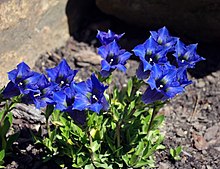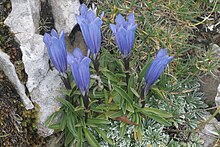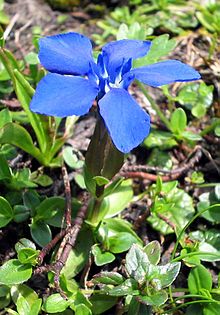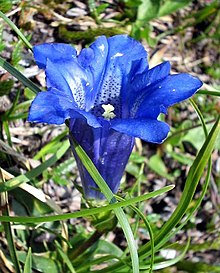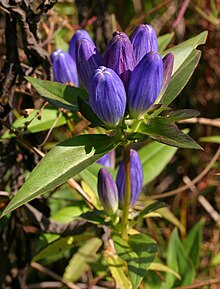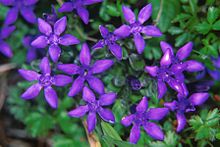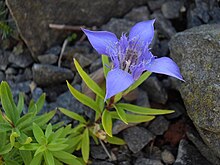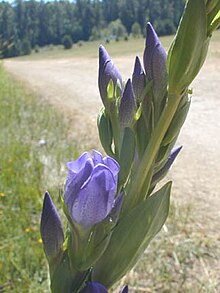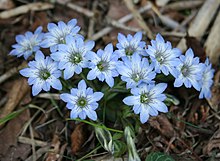
The hybrid Macauleys Enzian ( Gentiana × macauleyi ) created by horticultural crossing of Gentiana farreri and Gentiana sino-ornata
-
Gentiana abaensis T.N.Ho : It thrives at altitudes of around 3300 meters in southern Gansu and northern Sichuan .
-
Kochscher gentian , silicate bell gentian ( Gentiana acaulis L. ): It thrives in European mountains: in the Alps , Carpathians , on the northern Balkan peninsula , in the Apennines , in the Pyrenees , in the Cantabrian Mountains and in the Iberian Mountains . Gentiana acaulis is protected in Germany and Bulgaria and regionally in France and Switzerland . Gentiana acaulis is extinct in the Czech Republic . There are localities for Spain , Andorra , France , Italy , Switzerland , Liechtenstein , Austria , Germany , Slovenia , Bosnia and Herzegovina , Croatia , Serbia , Bulgaria , Montenegro , Albania , Romania and the Ukraine .
-
Gentiana affinis Griseb. : It occurs in western Canada and the western and central United States.
-
Gentiana alata T.N.Ho : It thrives in forest clearings at altitudes of 1200 to 2000 meters only in central Yunnan .
-
Gentiana albicalyx Burkill : It occurs in northwestern India , Nepal , Bhutan , Sikkim and in southern Tibet .
-
Gentiana albomarginata C. Marquand : It thrives on grasslands at altitudes from 1900 to 3300 meters only in northwestern Yunnan.
-
Gentiana algida Pall. : It occurs in North America, India, Bhutan and the temperate areas of Asia.
-
Gentiana alii (Omer & Qaiser) TNHo
-
Alpine gentian ( Gentiana alpina Vill. ): It occurs in the southwest and western parts of the Middle Alps , in the Middle Pyrenees and in the Sierra Nevada in southern Spain .
-
Gentiana alsinoides Franch. : It thrives at altitudes of 2700 to 3400 meters in western Sichuan and northwestern Yunnan.
-
Gentiana altigena Harry Sm .: It occurs in northeast India, Tibet and Yunnan.
-
Gentiana altorum Harry Sm. Ex C. Marquand : It thrives at altitudes of 3700 to 4200 meters in Sichuan and Tibet.
-
Gentiana × ambigua Hayek
-
Gentiana amplicrater Burkill : It occurs in India, Nepal and in southeastern Tibet.
-
Gentiana andrewsii Griseb. : It is found in Canada and the eastern and central United States.
-
Narrow-leaved gentian ( Gentiana angustifolia Vill. ): It occurs in two subspecies in Spain, France, Italy and Switzerland.
-
Gentiana angustifolia subsp. angustifolia
-
Gentiana angustifolia subsp. corbariensis (Brown-Blanq.) Renob. (Syn .: Gentiana occidentalis Jakow. ): It occurs in Spain and France.
-
Gentiana anisostemon C.Marquand : It thrives in altitudes from 3600 to 4300 meters only in northwestern Yunnan.
-
Gentiana annaverae Pînzaru
-
Gentiana aperta Maxim. : It thrives in two varieties at altitudes of 2000 to 4000 meters only in northeastern Qinghai.
-
Gentiana apiata N.E.Br. : This endemic thrives on slopes at altitudes of 1900 to 3400 meters only in Taibai Shan in the Chinese province of Shaanxi .
-
Gentiana aquatica L .: It occurs in Kazakhstan, Mongolia, Russia, Tajikistan and western Tibet.
-
Gentiana arenicola Kerr
-
Gentiana arethusae Burkill : The two varieties thrive at altitudes of 2000 to 4800 meters in southeastern Tibet and in the Chinese provinces of eastern Sichuan and northwestern Yunnan.
-
Gentiana argentea (Royle ex D.Don) Royle ex D.Don
-
Gentiana arisanensis Hayata : It thrives at altitudes of 2500 to 3900 meters in the central mountain range of the island of Taiwan .
-
Gentiana aristata Maxim. : It thrives at altitudes of 1,800 to 4,600 meters in Tibet and in the Chinese provinces of Gansu, Qinghai and Sichuan.
-
Swallowwort gentian ( Gentiana asclepiadea L. ): It thrives mainly in the mountains of Central and Southern Europe.
-
Gentiana asterocalyx Diels : It thrives at altitudes of 3000 to 3200 meters only in northwestern Yunnan.
-
Gentiana atlantica litard. & Maire : It occurs in Morocco.
-
Gentiana atuntsiensis W.W.Sm. : It thrives at altitudes of 2700 to 4800 meters in southeastern Tibet and northwestern Yunnan.
-
Gentiana austromontana J.S. Pringle & Sharp
-
Gentiana autumnalis L .: It occurs in the US states of New Jersey , Delaware , North Carolina , South Carolina and Virginia .
-
Gentiana axilliflora Levl. & Vaniot
-
Gentiana baeuerlenii L.G. Adams
-
Gentiana bambuseti T.Y.Hsieh, TCHsu, SMKu & CI Peng : It was first described in 2007. This endemic thrives in bamboo forests at altitudes of around 1500 meters only in Chiayi in Taiwan.
-
Bavarian gentian ( Gentiana bavarica L. ): It occurs in the Alps and the Carpathians.
-
Gentiana beamanii J.S. Pringle
-
Gentiana Bella Franch. ex Hemsl. : It occurs in northern Myanmar and northwestern Yunnan.
-
Gentiana bicuspidata (G.Don) Briq. : It thrives in the mountains of central and northwestern Mexico .
-
Gentiana × billingtonii Farw.
-
Gentiana boissieri Schott & Kotschy ex Boiss. : It occurs in Turkey.
-
Gentiana bokorensis Hul
-
Gentiana borneensis Hook. f.
-
Gentiana boryi Boiss. : It only occurs in Spain.
-
Short-leaf gentian ( Gentiana brachyphylla Vill. ): It occurs in the Alps, in the Pyrenees and in the Spanish Sierra Nevada .
-
Gentiana brentae Prosser & Bertolli
-
Gentiana bryoides Burkill : It occurs in Tibet, Nepal, Bhutan and Sikkim.
-
Gentiana burseri Lapeyr. : It occurs in Spain, France and Italy. There are two subspecies:
-
Gentiana cachemirica Decne.
-
Gentiana caelestis (C.Marquand) Harry Sm .: It occurs in Myanmar and China.
-
Gentiana caeruleogrisea T.N.Ho : It thrives at altitudes of 3600 to 4300 meters in China.
-
Gentiana caliculata Lex .: It occurs in central to western Mexico.
-
Gentiana calycosa Griseb.
-
Gentiana capitata Buch.-Ham. ex D.Don : It occurs in Tibet, Myanmar , India, Kashmir , Bhutan, Nepal and Sikkim.
-
Gentiana carinata (D.Don) Griseb.
-
Gentiana carinicostata Wernham
-
Gentiana caryophyllea Harry Sm . : It occurs in Yunnan and Myanmar.
-
Gentiana catesbaei Walter
-
Gentiana cephalantha Franch. ex Hemsl. : It occurs in China and in Thailand, Myanmar and Vietnam.
-
Gentiana cephalodes Edgew.
-
Gentiana × charpentieri Thomas ex Hegetschw.
-
Gentiana chazaroi H.H. Iltis : It was first described in 1994. It is only known from its type location in the Mexican state of Durango near Pueblo Nuevo on the Durango – Mazatlán road. It thrives at altitudes of 2400 to 2500 meters.
-
Gentiana chateri T.N.Ho
-
Gentiana chinensis Kusn. : It thrives at altitudes of 2,400 to 4,500 meters in the Chinese provinces of western Hubei, southwestern Sichuan and northwestern Yunnan.
-
Gentiana choanantha C.Marquand : It only thrives in western Sichuan at altitudes of 2700 to 4600 meters.
-
Gentiana chosenica Okuyama
-
Gentiana chungtienensis C. Marquand : It only thrives at altitudes of 3000 to 3700 meters in northwestern Yunnan.
-
Gentiana Clarkei Kusn. : It thrives on alpine mats at altitudes of 4600 to 5300 meters in western Tibet and in Qinghai.
-
Gentiana clausa Raf.
-
Clusius gentian , lime bell gentian, stemless gentian ( Gentiana clusii Perr. & Songeon ): It occurs in the Alps, in the foothills of the Alps, in the Jura, in the Black Forest and in the Carpathians.
-
Gentiana confertifolia C.Marquand : It thrives at altitudes of 3000 to 3400 meters only in northwestern Yunnan.
-
Gentiana coronata (D. Don ex Royle) Griseb.
-
Gentiana crassa short
-
Gentiana crassicaulis Duthie ex Burkill : It occurs in Tibet and in the Chinese provinces of Guizhou, Sichuan and Yunnan.
-
Gentiana crassula Harry Sm .: It thrives on grassy slopes at altitudes of 3400 to 4200 meters in the Chinese provinces of Sichuan and northwestern Yunnan.
-
Gentiana crassuloides Bureau & Franch. : It occurs in China, India, Bhutan, Nepal and Sikkim.
-
Gentiana cristata Harry Sm .: It thrives on grassy slopes at altitudes of about 4200 meters in southeastern Tibet and northwestern Yunnan.
-
Cross gentian ( Gentiana cruciata L. ): It occurs in Europe and Western Asia.
-
Gentiana cruttwellii Harry Sm.
-
Gentiana cuneibarba Harry Sm . : It occurs in China and in Bhutan and Myanmar .
-
Gentiana × curtisii J.S. Pringle
-
Gentiana dahurica fish. : It occurs in China, Mongolia and Siberia .
-
Gentiana damyonensis C.Marquand : It occurs in China and in the northeastern Myanmar.
-
Gentiana davidii Franch. : The three varieties thrive at altitudes of 300 to 3000 meters in three varieties in Taiwan and in the Chinese provinces of Anhui, Fujian, Guangdong, Guangxi, Hainan, Henan, Hubei, Hunan, Jiangsu, Jiangxi and Zhejiang.
-
Gentiana decemfida Buch.-Ham. ex D.Don
-
Gentiana decora Pollard
-
Gentiana decorata Diels : It occurs in China and northeastern Myanmar.
-
Narrow-leaved gentian ( Gentiana decumbens L. f. ): It occurs in European Russia , Siberia, Kazakhstan , Mongolia and China.
-
Gentiana delavayi Franch. : It thrives at altitudes of 1400 to 3900 meters in the Chinese provinces of southwestern Sichuan, northeastern and northwestern Yunnan.
-
Gentiana deltoidea Harry Sm .: It thrives on grassy slopes at altitudes of 3300 to 3700 meters in the Chinese provinces of southwest Sichuan and northwest Yunnan.
-
Gentiana dendrologi C.Marquand : It thrives at altitudes of 3000 to 4500 meters in Sichuan.
-
Gentiana densiflora T.N.Ho : It thrives at altitudes of 900 to 3000 meters in the Chinese provinces of Guizhou and eastern Sichuan.
-
Gentiana depressa D.Don : It occurs in Tibet, India, Bhutan, Nepal and Sikkim.
-
Gentiana × digenea Jakow.
-
Dinaric gentian ( Gentiana dinarica Beck ): It thrives in the mountains in the southwest of the former Yugoslavia , in Albania and in central Italy ( Abruzzo ).
-
Gentiana divaricata T.N.Ho : It was first described in 1984. It thrives on slopes in shady forests at an altitude of about 2300 meters only in southwest Sichuan.
-
Gentiana diversifolia Merr.
-
Gentiana douglasiana bong. : It occurs in western North America in Alaska , British Columbia and Washington .
-
Gentiana doxiongshangensis T.N.Ho : It occurs in Tibet, Bhutan and northeast India.
-
Gentiana dschungarica rule
-
Gentiana duclouxii Franch. : It thrives on hills at altitudes of 1800 to 1900 meters only in central Yunnan.
-
Gentiana durangensis Villarreal : It was first described in 1996. It is only known from one site in the Mexican state of Durango near the city of Durango. It thrives at an altitude of about 2600 meters.
-
Gentiana ecaudata C.Marquand : It thrives at altitudes of 3000 to 4500 meters in Sichuan and Yunnan.
-
Gentiana elmeriana Halda
-
Gentiana elwesii C.B.Clarke : It occurs in Tibet, India, Nepal, Bhutan and Sikkim.
-
Gentiana emodi C. Marquand ex Sealy : It occurs in Tibet, Bhutan and Sikkim.
-
Gentiana ettingshausenii F. Muell.
-
Gentiana exigua Harry Sm .: It thrives at altitudes of 1500 to 3200 meters in southwest Sichuan and northwest Yunnan.
-
Gentiana expansa Harry Sm .: It thrives at altitudes of 1100 to 2100 meters in central and northwestern Yunnan.
-
Gentiana faucipilosa Harry Sm . : It occurs in Tibet, Yunnan and Bhutan.
-
Gentiana fieldiana J.S. Pringle
-
Gentiana filistyla Balf. f. & Forrest : It occurs in China and Myanmar.
-
Gentiana flavida A.Gray (Syn .: Gentiana alba Muhl. Ex A.Gray ): It occurs in Ontario and in the eastern and central United States.
-
Gentiana flavomaculata Hayata : There have been two varieties since 1999. They thrive on grassy slopes at altitudes of 1,600 to 3,000 meters in the central mountain range of the island of Taiwan.
-
Gentiana flexicaulis Harry Sm .: It thrives at altitudes of 2,400 to 4,600 meters in Sichuan.
-
Gentiana formosa Harry Sm .: It thrives at altitudes of 2700 to 4200 meters in China.
-
Gentiana forrestii C. Marquand : It thrives at altitudes of 3000 to 4200 meters in China.
-
Gentiana franchetiana Kusn. : It thrives on hills at altitudes of 1400 to 2300 meters in the Chinese provinces of southwestern Sichuan and central and northwestern Yunnan.
-
Gentiana Fremontii Torr.
-
Tauern gentian ( Gentiana frigida Haenke ): It occurs mainly in the Carpathian Mountains and occasionally in the Eastern Alps.
-
Karawanken gentian ( Gentiana froelichii Jan ex Rchb. ): There are the following subspecies:
-
Gentiana futtereri Diels & Gilg : It thrives on alpine meadows and in mountain forests at altitudes of 2800 to 3400 meters in the Chinese provinces of southwestern Gansu and southeastern Qinghai.
-
Gentiana × gaudiniana Thomas ex WDJKoch
-
Gentiana gelida M.Bieb. : It occurs in Turkey , Iran , Azerbaijan and Armenia .
-
Gentiana gentilis Franch. : It thrives at altitudes of 2000 to 2700 meters in central Yunnan.
-
Gentiana georgei Diels : It thrives at altitudes of 3000 to 4200 meters in the Chinese provinces of southern Gansu, southern Qinghai, northern Sichuan, northeastern Yunnan.
-
Gentiana gilvostriata C.Marquand : It occurs in Tibet, Yunnan, India, Bhutan and Myanmar.
-
Gentiana glauca Pall. : It occurs in Siberia, Japan , Russia's Far East, Alaska , Canada and Montana .
-
Gentiana grandiflora Laxm.
-
Gentiana × grandilacustris J.S.Pringle
-
Gentiana grata Harry Sm .: It occurs in southeastern Tibet, northwestern Yunnan and northeastern Myanmar.
-
Gentiana × grisebachiana Rouy
-
Gentiana grumii Kusn. : It thrives at altitudes of 3200 to 3300 meters in Qinghai.
-
Gentiana gyirongensis T.N.Ho : It occurs in Tibet and Nepal.
-
Gentiana × haengstii Hausm.
-
Gentiana handeliana Harry Sm .: It occurs in southeastern Tibet and northwestern Yunnan and northeastern Myanmar.
-
Gentiana haraldi-smithii Halda
-
Gentiana harrowiana Diels : It occurs in Yunnan and northeastern Myanmar.
-
Gentiana haynaldii Kanitz : It thrives at altitudes of 2100 to 4200 meters in China.
-
Gentiana heleonastes Harry Sm .: It thrives at altitudes of 3200 to 4200 meters in China.
-
Gentiana helophila Balf. f. & Forrest : It occurs in northwestern Yunnan.
-
Gentiana hesseliana Hosseus
-
Gentiana hexaphylla Maxim. ex Kusn. : It thrives at altitudes of 2700 to 4400 meters in the Chinese provinces of southern Gansu, southeastern Qinghai, Shaanxi (only in Taibai Shan), northern and western Sichuan.
-
Gentiana himalayensis T.N.Ho : It occurs in Tibet, Nepal, Bhutan and Sikkim.
-
Gentiana hintoniorum B.L. Turner : It was first described in 1996. It is only known from the type location in the Mexican state of Nuevo León in the Sierra Madre Oriental on Cerro Viejo. It thrives at altitudes of 2300 to 2800 meters.
-
Gentiana hirsuta Ma & EWMa ex TNHo : It thrives on grassy slopes at an altitude of around 2900 meters only in western Sichuan.
-
Gentiana hooperi J.S.Pringle : It thrives in altitudes from 2,300 to 3,100 meters in the mountains in the central and northwestern Mexico.
-
Gentiana horaimontana Masamune : This rare endemic thrives at altitudes of 3600 to 3900 meters only in the southern part of the central mountain range on the island of Taiwan.
-
Gentiana hugelii Griseb.
-
Gentiana huxleyi Kusn. : It occurs in southern Tibet, Pakistan, India, Nepal, Bhutan and Sikkim.
-
Gentiana × hybrida Schleich. ex DC.
-
Gentiana infelix C.B.Clarke : It occurs in southern and southeastern Tibet and in western Yunnan, Bhutan, Sikkim and Myanmar.
-
Gentiana intricata C.Marquand : It thrives at altitudes of 2200 to 3500 meters in southeastern Tibet and northwestern Yunnan.
-
Gentiana itzershanensis Liu & Kuo : This endemic thrives at altitudes of 2800 to 3800 meters only in the Hsuehshan mountain range on the island of Taiwan.
-
Gentiana jaeschkei Briefly
-
Gentiana jamesii Hemsl. : It occurs in China, Japan, Korea and eastern Russia.
-
Gentiana jarmilae Halda
-
Gentiana jingdongensis T.N.Ho : It thrives on slopes on roads at altitudes of 2800 to 2900 meters only in central Yunnan.
-
Gentiana jouyana Hul
-
Gentiana kaohsiungensis Chih H.Chen & JCWang : It was first described in 1999. This endemic thrives at altitudes of 2400 to 3200 meters only in the southern part of the central mountain range on the island of Taiwan.
-
Gentiana kaufmanniana Regel & Schmalh. : It occurs in Afghanistan , Pakistan , Tajikistan , Kazakhstan , Kyrgyzstan and in China.
-
Gentiana khammouanensis Hul
-
Gentiana kurroo Royle : It occurs in India, Pakistan and Nepal. It is used as a medicinal plant and therefore collected in nature, so the stocks are decreasing and Gentiana kurroo is endangered.
-
Gentiana lacerulata Harry Sm . : It occurs in Tibet and in India, Nepal, Bhutan and Sikkim.
-
Gentiana laevigata M.Martens & Galeotti : It thrives at altitudes of 1900 to 2800 meters in the Sierra Madre del Sur in the Mexican state of Oaxaca and in Chiapas .
-
Gentiana langbianensis A. Chev. ex S.Hul
-
Gentiana lateriflora Hemsl.
-
Gentiana latidens (House) JSPringle & Weakley
-
Gentiana lawrencei Burkill : The two varieties thrive at altitudes of 2400 to 4600 meters in the Chinese provinces of southwest Gansu, Qinghai, western and northern Sichuan.
-
Gentiana laxiflora T.N.Ho : It only thrives at altitudes of 4100 to 4200 meters in southeastern Tibet.
-
Gentiana leptoclada Balf. f. & Forrest : It only thrives in northwestern Yunnan at altitudes of 2100 to 3000 meters.
-
Gentiana leroyana Hul
-
Gentiana leucomelaena Maxim. : It occurs in China and in Kashmir, Kazakhstan, Kyrgyzstan, Mongolia, Nepal, Pakistan, Russia, Sikkim and Tajikistan.
-
Gentiana lhassica Burkill : It thrives at altitudes of 4200 to 4900 meters in southwestern Qinghai and in eastern Tibet.
-
Gentiana liangshanensis Z.Y.Zhu
-
Gentiana licentii Harry Sm .: It thrives on slopes only in southeastern Gansu .
-
Ligurian gentian ( Gentiana ligustica R.Vilm. & Chopinet ): It occurs in France only in the Maritime Alps and in Italy only in Liguria and Piedmont . The stocks are considered stable.
-
Gentiana linearis Froel.
-
Gentiana lineolata Franch. : It thrives at altitudes of 600 to 4000 meters in Yunnan and southwest Sichuan.
-
Gentiana linoides Franch. ex Hemsl. : It thrives only in northwestern Yunnan at altitudes of 3000 to 4000 meters.
-
Gentiana loerzingii Ridl.
-
Gentiana longicollis G.L.Nesom : It was first described in 1990. It is only known from the type location in the Mexican state of Durango in the Municipio Mezquital . It thrives at an altitude of 2400 to 2800 meters.
-
Gentiana loureiroi (G.Don) Griseb. : It occurs in India, Bhutan, Thailand , Myanmar, Laos , Vietnam , and in the Chinese provinces of Fujian , Guangdong , Guangxi , Hainan , Hunan Jiangsu , Jiangxi and Zhejiang . Occurrences in Taiwan could not be confirmed.
-
Gentiana lowryi Hul
-
Yellow gentian ( Gentiana lutea L. ): It is widespread in the mountains of Central and Southern Europe.
-
Gentiana lycopodioides Stapf
-
Gentiana macgregoryi Hemsl.
-
Gentiana macrophylla Pall. : It occurs in Kazakhstan, Siberia, China, Mongolia and Russia's Far East.
-
Gentiana maeulchanensis Franch. : It occurs in southern Tibet, northwestern Yunnan and in Bhutan, Sikkim and northern Myanmar.
-
Gentiana mairei H.Lév. : It thrives at altitudes of 2,400 to 4,000 meters in the Chinese provinces of southwestern Sichuan and northeastern Yunnan.
-
Gentiana makinoi Kusn. : This endemic occurs only on the Japanese island of Honshu .
-
Gentiana manshurica Kitag. : It occurs in the Chinese provinces of Anhui , Fujian, Guangdong, Guangxi, Hainan, Hebei , Heilongjiang , Henan , Hubei, Hunan, Jiangsu, Jiangxi, Jilin , Liaoning , Nei Mongol , Ningxia , Shaanxi , Shandong , Shanxi and Zhejiang. No herbarium specimens could be found that would confirm an occurrence in Taiwan.
-
Gentiana × marcailhouana Rouy
-
Gentiana × marceli-jouseaui Halda
-
Gentiana masonii T.N.Ho
-
Gentiana × media Arv.-Touv.
-
Gentiana meiantha (CBClarke) Harry Sm.
-
Gentiana melandriifolia Franch. ex Hemsl. : It thrives at altitudes of 2200 to 3000 meters in Yunnan.
-
Gentiana membranulifera T.N.Ho
-
Gentiana micans C.B.Clarke : It occurs in southeastern Tibet and in Ghutan , Nepal and Sikkim.
-
Gentiana micantiformis Burkill : It occurs in Qinghai and in southern and southeastern Tibet, in Bhutan and in Sikkim.
-
Gentiana microdonta Franch. ex Hemsl. : It only thrives in northwestern Yunnan at altitudes of 2600 to 4200 meters.
-
Gentiana microphyta Franch. ex Hemsl. : It occurs in northwestern Yunnan and northeastern Myanmar.
-
Gentiana mirandae Paray : It thrives at altitudes of 2000 to 2500 meters in the central Mexican states of Hidalgo , Guerrero and Veracruz .
-
Gentiana moniliformis C. Marquand : It thrives on hills at an altitude of about 2100 meters only in western Yunnan.
-
Gentiana muscicola C.Marquand : It occurs in southeastern Tibet, northwestern Yunnan and northeastern Myanmar.
-
Gentiana myrioclada Franch. : It occurs in two varieties in eastern Sichuan.
-
Gentiana namlaensis C. Marquand : It only thrives at altitudes of 4600 to 4900 meters in southeastern Tibet.
-
Gentiana nano bella C.Marquand : It thrives in altitudes from 2,700 to 4,300 meters in the south-eastern Tibet, western Sichuan and the northwestern Yunnan.
-
Gentiana nerterifolia P.Royen
-
Gentiana newberryi A. Gray
-
Gentiana nipponica Maxim.
-
Snow gentian ( Gentiana nivalis L. ): It is widespread in the mountains of southern and central Europe, northern Europe and North America.
-
Gentiana nubigena Edgew. : It occurs in Gansu, Qinghai, Tibet and Bhutan, in northwestern India, in Kashmir, Nepal and Sikkim.
-
Gentiana nudicaulis short
-
Gentiana nyalamensis T.N.Ho : It occurs in two varieties in southern Tibet and Bhutan.
-
Gentiana obconica T.N.Ho : It occurs in southern and south-eastern Tibet, in Sikkim, Bhutan and in eastern Nepal.
-
Gentiana occidentalis Jakow. : It occurs in the former Yugoslavia.
-
Gentiana officinalis Harry Sm .: It thrives at altitudes of 2300 to 4200 meters in southern Gansu, southeastern Qinghai, southern Shaanxi and northern Sichuan.
-
Gentiana olgae rule ex Schmalh. : It occurs in Kazakhstan, Kyrgyzstan and Tajikistan.
-
Gentiana oligophylla Harry Sm .: It thrives at altitudes from 1800 to 2800 meters in Guizhou, Hubei, Hunan and in eastern Sichuan.
-
Gentiana olivieri Griseb. : It occurs in Turkey, Iran, Afghanistan, Armenia , Iraq , Syria , Pakistan, Kazakhstan, Tajikistan, Turkmenistan , Kyrgyzstan, Uzbekistan and Xinjiang .
-
Gentiana oppositifolia Zaw. ex Griseb.
-
Round-leaved gentian ( Gentiana orbicularis Schur ): It is widespread in Europe in the Alps and other mountains from southern Spain to the northern Balkans.
-
Gentiana oreodoxa Harry Sm .: It occurs in southeastern Tibet, northwestern Yunnan, Bhutan and northeastern Myanmar.
-
Gentiana ornata (D.Don) Wall. ex Griseb. : It occurs in southern Tibet, Bhutan, Sikkim and eastern Nepal.
-
Gentiana Otophora Franch. ex Hemsl. : It occurs in southeastern Tibet, northwestern Yunnan and northeastern Myanmar.
-
Gentiana otophoroides Harry Sm .: It thrives at altitudes of 3200 to 4100 meters in southeastern Tibet and northwestern Yunnan.
-
Gentiana ovatiloba Kusn. : There are two varieties. One occurs in the mountains of central Mexico and in an isolated location in Guatemala. The other only thrives at higher altitudes of 3200 to 3450 meters on Cerro San Andrés in the Los Azufres region in the northwest of the Mexican state of Michoacán .
-
Gentiana pachyphylla Merr.
-
Gentiana × pallidocyanea J.S.Pringle
-
Eastern Alpine gentian , Pannonian gentian, Hungarian gentian ( Gentiana pannonica Scop. ): There are localities for Germany, Austria, Switzerland, Italy, the Czech Republic and Slovenia. The main distribution area is in the Eastern Alps. In Germany, Gentiana pannonica occurs only at two small sites in the border area with Austria. The populations are decreasing and Gentiana pannonica is considered endangered.
-
Gentiana panthaica Prain & Burkill : It thrives at altitudes of 1,600 to 3,800 meters in Guangxi, Guizhou, Hunan, Jiangxi, Sichuan and Yunnan.
-
Gentiana papillosa Franch. : It thrives at altitudes of 2200 to 2800 meters in southwest Sichuan and in central and northwest Yunnan.
-
Gentiana paradoxa Albov
-
Gentiana parryae C.Marquand
-
Gentiana parryi Engelm.
-
Gentiana parvula Harry Sm .: It thrives in sandy locations at an altitude of about 3300 meters only in southwest Sichuan.
-
Gentiana pedata Harry Sm .: It thrives at altitudes of 1900 to 3000 meters in southwest Sichuan, northeast Yunnan and in Guizhou.
-
Gentiana pedicellata (D.Don) Wall. : It occurs in Pakistan, India, Bhutan, Nepal, Myanmar, Tibet and Yunnan.
-
Gentiana penetii (Litard. & Maire) Romo : It occurs in Morocco and Spain.
-
Gentiana perpusilla Brandegee : It thrives at higher altitudes of 3590 to 3900 meters in the volcanic chain in the Mexican states of México and Veracruz.
-
Gentiana phyllocalyx C.B. Clarke : It occurs in southeastern Tibet and northwestern Yunnan, in India, Bhutan, Nepal, Sikkim and in northern Myanmar.
-
Gentiana piasezkii Maxim. : It thrives at altitudes of 1000 to 4300 meters in southeastern Gansu and in northern Sichuan.
-
Gentiana picta Franch. ex Hemsl. : It thrives at altitudes of 2400 to 3000 meters in southwest Sichuan and in central and northwestern Yunnan.
-
Gentiana platypetala Griseb. : It occurs in Alaska and British Columbia .
-
Gentiana plurisetosa C.T. Mason
-
Lung gentian ( Gentiana pneumonanthe L. ): It is widespread in large parts of Europe, in temperate Asia and in parts of the Caucasus.
-
Gentiana praeclara C.Marquand : It thrives at altitudes of 1500 to 4200 meters in southwest Sichuan and northwest Yunnan.
-
Gentiana praticola Franch. : It thrives at altitudes of 1200 to 3200 meters in northwestern Yunnan, Sichuan and Guizhou.
-
Gentiana prattii Kusn. : It thrives at altitudes of 3000 to 4000 meters in northwestern Yunnan, in western Sichuan and in Qinghai.
-
Gentiana primuliflora Franch. : It thrives at altitudes of 1,800 to 3,900 meters in southwest Sichuan and in central and northwestern Yunnan.
-
Gentiana pringlei Shabir : This species is endemic to the Indian state of Ladakh.
-
Gentiana producta T.N.Ho : It occurs in Sichuan.
-
Gentiana prolata Balf. f. : It occurs in southeastern Tibet, northeastern India, Bhutan, Nepal and Sikkim.
-
Lying gentian ( Gentiana prostrata Haenke ): It occurs in Central Europe , in Kazakhstan, Kyrgyzstan, Tajikistan, in Mongolia, in China, Nepal, Russia and in North America.
-
Gentiana pseudosquarrosa Harry Sm .: It thrives at altitudes of 1400 to 3800 meters in southeastern Tibet, southwestern Qinghai, western Sichuan and northwestern Yunnan.
-
Gentiana pterocalyx Franch. : It thrives at altitudes of 1,700 to 3,500 meters in western Guizhou, southwestern Sichuan, and northern Yunnan.
-
Gentiana puberulenta J.S. Pringle : It is found in Canada and the United States.
-
Gentiana pubigera C. Marquand : It only thrives at altitudes of 2400 to 3800 meters in northwestern Yunnan.
-
Gentiana pulvinarum W.W.Sm.
-
Lesser gentian ( Gentiana pumila Jacq. )
-
Gentiana pumilio Standl. & Steyerm. : It thrives at altitudes of 2500 to 4070 meters in the Sierra Madre in southwest Guatemala and in southern Chiapas .
-
Spotted gentian ( Gentiana punctata L. ): It thrives in European mountains: in the Alps, the Carpathians and the Balkan Peninsula.
-
Purple gentian ( Gentiana purpurea L. ): It occurs mainly in the western Alps (up to the Arlberg ), in the Apennines and in Norway.
-
Gentiana pyrenaica L .: It occurs in Spain, France, Bulgaria, Turkey, Armenia and Ukraine.
-
Gentiana qiujiangensis T.N.Ho : It only thrives in north-western Yunnan at altitudes of around 3900 meters.
-
Gentiana quadrifaria flower
-
Gentiana radiata C.Marquand : It thrives at altitudes of 4100 to 4500 meters only in southwest Sichuan.
-
Gentiana recurvata C.B.Clarke : It occurs in southeastern Tibet and northwestern Yunnan, in northeastern Myanmar, in eastern Nepal and in Sikkim.
-
Gentiana rhodantha Franch. ex Hemsl. : It occurs in Gansu, Guangxi, Henan, western Hubei, southern Shaanxi, southwest Sichuan and Yunnan.
-
Gentiana riparia Kar. & Kir. : It occurs in Southwest Asia , in Kashmir, Kazakhstan, in Siberia, in China and in Mongolia.
-
Gentiana robusta King ex Hook. f. : It occurs in Tibet, Nepal and Sikkim.
-
Gentiana rostanii Reut. ex Verlot : It occurs in France and Italy.
-
Gentiana rubicunda Franch. : It occurs in four varieties in Gansu, Guizhou, Hubei, Hunan, Sichuan and Yunnan.
-
Gentiana rubricaulis pig. : It occurs in the central to eastern United States and Canada.
-
Gentiana sagarmathae Miyam. & H.Ohba
-
Gentiana saginifolia Wernham
-
Gentiana saginoides Burkill
-
Gentiana saltuum C.Marquand
-
Gentiana saponaria L .: It occurs in Alabama and Florida .
-
Gentiana satsunanensis T.Yamaz.
-
Japanese gentian ( Gentiana scabra Bunge ): It is found in Japan, Korea, China, Siberia and Russia's Far East.
-
Gentiana scabrida Hayata (Syn .: Gentiana taiwanica T.N.Ho ): The two varieties thrive at altitudes of 2300 to 3800 meters in the central and southern part of the central mountain range of the island of Taiwan.
-
Gentiana sceptrum Griseb. : It occurs in western North America from the Canadian province of British Columbia via the US states of Washington, Oregon to California.
-
Gentiana sedifolia Kunth
-
Gentiana septemfida Pall. : It occurs in Norway , Lithuania , Latvia , Estonia , Russia, Siberia, the Caucasus , Xinjiang , Turkey, Iran and the Crimea .
-
Gentiana serra Franch. : It thrives only in northwestern Yunnan at altitudes of 2400 to 4400 meters.
-
Gentiana setigera A. Gray
-
Gentiana shaanxiensis T.N.Ho : It occurs in Shaanxi .
-
Gentiana sierrae Briq. : It occurs in Spain.
-
Gentiana sikkimensis C.B.Clarke : It occurs in southern and southeastern Tibet, northwestern Yunnan, Bhutan, India, northeastern Myanmar, Nepal and Sikkim.
-
Gentiana sikokiana Maxim.
-
Gentiana simulatrix C.Marquand : It occurs in Bhutan, in southwest Sichuan and in southeast Tibet.
-
Chinese jewelry gentian ( Gentiana sino-ornata Balf. F. ): It occurs in China and Myanmar.
-
Gentiana siphonantha Maxim. ex Kusn. : It thrives at altitudes of 1,800 to 4,500 meters in Gansu, Ningxia , Qinghai and northwestern Sichuan.
-
Gentiana souliei Franch. : It thrives at altitudes of 3200 to 3900 meters in western Sichuan and northwestern Yunnan.
-
Gentiana spathacea Kunth : It occurs from central Mexico to the Sierra Madre.
-
Gentiana spathulifolia Kusn. : It occurs in two varieties in southern and western Gansu, in southeastern Qinghai, in Shaanxi and in northern Sichuan at altitudes of 2800 to 3800 meters.
-
Gentiana spathulisepala T.N.Ho & SWLiu : It occurs in northwestern Yunnan.
-
Gentiana squarrosa Ledeb. : It occurs in north-western India, Kazakhstan, Korea, Kyrgyzstan, Mongolia, China, Nepal, Pakistan and eastern Russia.
-
Gentiana stellata Turrill : It occurs in southeastern Tibet, Nepal, Bhutan and northwestern India.
-
Gentiana stellulata Harry Sm .: It occurs in two varieties in northwestern Yunnan at altitudes of 3200 to 4000 meters.
-
Gentiana stipitata Edgew. : It occurs in two subspecies in Gansu, Qinghai, western Sichuan, Tibet, northwestern India and Nepal.
-
Gentiana stragulata Balf. f. & Forrest : It thrives at altitudes of 3,000 to 4,300 meters in southeastern Tibet and northwestern Yunnan.
-
Gentiana straminea Maxim. : It occurs in China and Nepal.
-
Gentiana striata Maxim. : It thrives at altitudes of 2200 to 3900 meters in Gansu, Ningxia, Qinghai and western Sichuan.
-
Gentiana stylophora C.B. Clarke
-
Gentiana suborbisepala C.Marquand : It comes in two varieties in Guizhou, in the southwestern and western Sichuan and Yunnan in the northeast at altitudes from 2200 to 4400 meters in front.
-
Gentiana subpolytrichoides Grubov
-
Gentiana subuliformis S.W.Liu : It thrives at altitudes of around 4800 meters only in southeastern Tibet.
-
Gentiana sumatrana Ridl.
-
Gentiana susamyrensis Pachom.
-
Gentiana sutchuenensis Franch. ex Hemsl. : It occurs in southern Gansu, Guizhou, southern Shaanxi, Sichuan and Yunnan.
-
Gentiana szechenyii Kanitz : It thrives at altitudes of 3000 to 4800 meters in southeastern Tibet, in southern Gansu, in Qinghai, in western Sichuan and in northwestern Yunnan.
-
Gentiana takushii T.Yamaz.
-
Gentiana taliensis Balf. f. & Forrest : It occurs in Guizhou, Sichuan, Yunnan and in Myanmar.
-
Gentiana tatakensis Masamune : This endemic thrives on grasslands at altitudes of 2500 to 3500 meters in the central and southern parts of the central mountain range of the island of Taiwan.
-
Gentiana tatsienensis Franch. : It thrives at altitudes of 3300 to 5000 meters in western Sichuan and in Tibet.
-
Gentiana tentyoensis Masamune (Syn .: Gentiana kaoi Shimizu ): This endemic thrives at altitudes of 1500 to 2400 meters only in northeastern Taiwan.
-
Gentiana tenuissima Hayata : This endemic thrives at altitudes of 50 to 2100 meters only in northeastern Taiwan.
-
Gentiana terglouensis Hacq.
-
Gentiana ternifolia Franch. : It thrives only in northern Yunnan at altitudes of 3,000 to 4,100 meters.
-
Gentiana tetraphylla Maxim. ex Kusn. : It thrives at altitudes of 3300 to 4500 meters in northern and western Sichuan.
-
Gentiana tetrasepala Biswas
-
Gentiana tetrasticha C. Marquand : It occurs in southern Tibet and Sikkim.
-
Gentiana thunbergii (G.Don) Griseb. : It occurs in two varieties in China, Japan and Korea.
-
Gentiana tianschanica Rupr. ex Kusn. : It occurs in northern Xinjiang, western Tibet, Pakistan, India, Nepal, Kazakhstan and Kyrgyzstan.
-
Gentiana tibetica King ex Hook. f. : It occurs in Bhutan, Nepal and Tibet.
-
Gentiana timida Kerr
-
Gentiana tongolensis Franch. : It thrives at altitudes of 3500 to 4800 meters in western Sichuan and eastern Tibet.
-
Gentiana tornezyana Litard. & Maire : It only occurs in Morocco.
-
Gentiana trichotoma Kusn. : It thrives at altitudes of 3000 to 4600 meters in Qinghai, in northwestern and western Sichuan and in Tibet.
-
Gentiana tricolor Diels & Gilg : It thrives at altitudes of 2200 to 3200 meters in Qinghai.
-
Gentiana triflora Pall. : It is common in Japan, Korea, Siberia , Mongolia, Inner Mongolia, Russia's Far East and the Chinese provinces of Hebei, Heilongjiang, Jilin and Liaoning.
-
Gentiana tubiflora (G.Don) Griseb. : It occurs in southern and southeastern Tibet, Bhutan, northwestern India, Nepal and Sikkim.
-
Gentiana uchiyamae Nakai : It occurs in Jilin and in Korea.
-
Gentiana ulmeri Merr.
-
Gentiana uniflora Georgi
-
Gentiana urnula Harry Sm .: It occurs in southwestern Qinghai, in eastern Tibet, in Bhutan, Nepal and Sikkim.
-
Hose gentian ( Gentiana utriculosa L. ): It occurs mainly in the mountains of Central Europe, Italy and the Balkan Peninsula.
-
Gentiana vandellioides Hemsl. : The two varieties thrive at altitudes of 1,100 to 3,500 meters in western Hubei, southern Shaanxi and eastern Sichuan.
-
Gentiana vandewateri Wernham
-
Gentiana veitchiorum Hemsl. : It occurs in China, Bhutan, Myanmar and Sikkim.
-
Gentiana venosa Hemsl.
-
Gentiana venusta (G.Don) Wall. ex Griseb.
-
Spring gentian , "Schusternagerl" ( Gentiana verna L. ): The five or so subspecies are widespread in Eurasia .
-
Gentiana vernayi C.Marquand : It comes in the southern and southeastern Tibet, before in Bhutan and Nepal.
-
Gentiana viatrix Harry Sm. Ex C. Marquand : It thrives at altitudes of 3400 to 4800 meters in northern and western Sichuan.
-
Gentiana villifera H.W.Li ex TNHo : It occurs in southeast Sichuan.
-
Gentiana villosa L.
-
Gentiana waltonii Burkill : It thrives at altitudes of 3000 to 4800 meters in southern and southeastern Tibet.
-
Gentiana walujewii Regel & Schmalh. : It occurs in northern Xinjiang and Kazakhstan .
-
Gentiana wangchukii E. Aitken & DGLong : This endemic thrives at altitudes of 4120 to 4720 meters only in central Bhutan . The stocks are in isolated locations and are considered stable in 2015.
-
Gentiana wardii W.W.Sm. : It occurs in three varieties in southwest Sichuan, northwest Yunnan, southeast Tibet and Myanmar.
-
Gentiana wasenensis C.Marquand : It thrives on slopes at elevations from 2,900 to 3,600 meters only in the northern Sichuan.
-
Gentiana wilsonii C.Marquand It thrives on grassy slopes, under bushes and in forests at altitudes of 2800 to 4000 meters in southeastern Tibet and in the Chinese provinces of southwestern Sichuan and northwestern Yunnan.
-
Gentiana winchuanensis T.N.Ho : It thrives in forests at altitudes of around 2400 meters only in northern Sichuan.
-
Gentiana wingecarribiensis L.G. Adams
-
Gentiana wootchuliana W.Paik
-
Gentiana xanthonannos Harry Sm .: It thrives on slopes and in forests at altitudes of 2100 to 2400 meters only in northwestern Yunnan.
-
Gentiana yakushimensis Makino : It occurs in Japan. The only herbarium evidence that this species is said to occur in Taiwan comes from Japan.
-
Gentiana yokusai Burkill : It occurs in two varieties in China, Japan and Korea.
-
Gentiana yunnanensis Franch. : It thrives at altitudes of 2300 to 4400 meters in southeastern Tibet and in the Chinese provinces of Guizhou, southwest to western Sichuan, northeast and northwest Yunnan.
-
Gentiana zekuensis T.N.Ho & SWLiu : It thrives on damp mats and under bushes at altitudes of 3200 to 3600 meters only in southeastern Qinghai .
-
Gentiana zhenxiongensis L.H.Wu & ZTWang : She was first described in 2012 from Yunnan.
-
Gentiana Zollingeri Fawc. : It occurs in China, Japan, Korea and eastern Russia.
|








